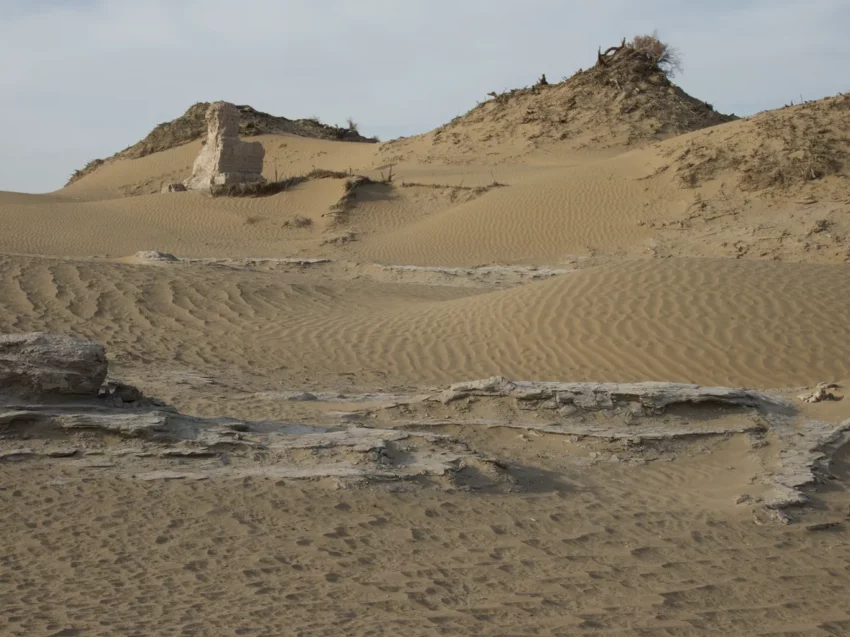Get your dose of History via Email
An Overview of the Niya Ruins
The Niya Ruins, a site of significant historical and archaeological value, are located in the Xinjiang Uyghur Autonomous Region of China. Once a prosperous outpost on the ancient Silk Road, the area now known as Niya was part of the Kingdom of Jingjue, an ancient kingdom referenced in Han Chinese chronicles. The ruins offer invaluable insight into the cultural exchanges and complex history of the region dating from the 2nd century BC to the 8th century AD.
Archaeological Explorations and Discoveries
Modern archaeological interest in the Niya site dates to the late 19th and early 20th centuries. Notably, British explorers such as Sir Aurel Stein were pivotal in bringing the ruins to international attention. Stein’s excavations, carried out in the early 1900s, uncovered a number of manuscripts, artifacts, and mummified remains that illuminated aspects of the everyday life, legal practices, and social structure of the ancient inhabitants. Further explorations by Japanese and Chinese teams have continued to enrich our understanding of the site, with the most recent excavations being conducted by the Xinjiang Archaeological Institute.
Findings and Interpretations
The items unearthed at the Niya ruins include wooden tablets bearing Kharosthi script, an ancient script used in the Gandhara region of North-West India, along with Chinese texts that showcase the cultural blending that occurred along the Silk Road. Textiles, coins, pottery, and household items found at the site have allowed researchers to piece together a narrative of domestic life and trade in the region. The study of these artifacts reveals that the people of Niya had established a complex society with a legal system, and that they engaged in farming a variety of crops including millet and wheat.
Preservation of Organic Material in Niya
The preservation of organic materials such as wood, textiles, and human remains is particularly striking at the Niya site, a phenomenon attributed to the arid conditions of the Tarim Basin. These materials provide a fascinating window into the past, offering physical evidence of the blend of Eastern and Western cultures that coexisted along the Silk Road.
The Environment and Ancient Climate
Analysis of the ruins and the surrounding environment suggests significant climatic changes occurred in the region. What was once a fertile environment with sufficient rainfall to support agriculture gradually became the arid desert landscape seen today, contributing to the abandonment of the site. The shifting climate patterns are a reminder of the environmental challenges faced by ancient civilizations and serve as a parallel to contemporary concerns about climate and sustainability.
The Significance of the Niya Site
The Niya site remains an important focus for archaeological research due to its unique position at the crossroads of multiple civilizations. The study of Niya offers exceptional opportunities to understand the dynamics of cultural exchange, adaptation, and the socio-economic aspects of life along the Silk Road. As an archaeological resource, Niya continues to yield data that contributes to the broader narrative of human history in Central Asia.
Challenges and Conservation Efforts
Despite its archaeological value, the Niya site faces challenges such as looting and the illegal trade of artifacts. These activities not only deprive the scholarly community of crucial information but also rob the local and global heritage of a tangible connection to the past. Efforts to protect the site and preserve its artifacts are ongoing, with a recognition of the need for greater measures to prevent the loss of this irreplaceable historical resource.
Conclusion
The Niya ruins stand as an emblem of the rich history of the Silk Road. Through ongoing archaeological work, conservation efforts, and scholarly analysis, the layers of history buried in the sands of Niya continue to reveal the complexities of ancient civilizations. The stories encapsulated within the remains at Niya demonstrate the enduring nature of human endeavor and the intricate web of historical connections that continue to shape our understanding of the past.

